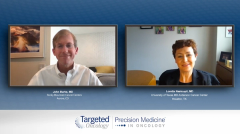
Findings From the LOTIS-2 Trial: Loncastuximab Tesirine
Experts discuss the LOTIS-2 trial that studied loncastuximab tesirine, a CD19-targeted monoclonal antibody for treating patients with relapsed/refractory diffuse large B-cell lymphoma.
Episodes in this series

Loretta Nastoupil, MD: There have been tremendous developments in the management of relapsed/refractory large cell lymphoma. Once of the most recent is the approval of loncastuximab. What is your impression of the data behind loncastuximab?
John Burke, MD: It looks good and promising, and I’m happy it became available. To summarize for the audience what it is, it’s an antibody-drug conjugate. It’s a humanized anti-CD19 antibody, linked to pyrrolobenzodiazepine, or PBD, which is a cytotoxin. It’s an antibody-drug conjugate. Like polatuzumab vedotin, which most people who treat lymphoma are probably familiar with, and like BV [brentuximab vedotin], it’s internalized after binding. The cytotoxin is released, and it causes cross links among DNA strands and helps kill the cell.
The study that they presented is the LOTIS-2 trial published in Lancet this year. It was an open-label, phase 2 design conducted in the United States and several European countries. Patients were eligible with relapse DLBCL [diffuse large B-cell lymphoma]. They had to have received at least 2 or more prior therapies, making it a little different from L-MIND, where they allowed many patients who had only 1 prior therapy. These patients all had received at least 2 prior therapies. Loncastuximab was dosed at 150 mcg/kg IV [intravenous] over 30 minutes once every 3 weeks. They gave 2 cycles of that dose, then cut the dose in half, down to 75 mcg/kg. They continued that 75 mcg/kg dose every 3 weeks for up to a year. The primary end point was the overall response rate. They reported on 184 patients who had received a median of 3 prior therapies. More than half had received at least 3 prior lines, and they’re pretty heavily pretreated populations with a fair number of prior transplants: 58% were refractory to their prior therapy, and even 9% had received prior CAR [chimeric antigen receptor] T-cell therapies.
We’re seeing these newer trials moving into the era of post-CAR T treatment. The toxicities looked to be pretty manageable. They reported 26% grade 3 neutropenia and only 3% febrile neutropenia. One of the unique toxicities for doctors to be familiar with is edema and fluid retention. They did see pleural effusions in about 10% of patients. They also report on an odd 1, which is elevated GGT levels, which do not seem to be accompanied necessarily by high levels of transaminase elevations or any serious liver problems. But that’s reported as something that they noticed in the study, perhaps not clinically significant. In terms of efficacy, they saw an overall response rate of 48% and a complete response of 24%. They do have time to event outcomes. The median duration of response was 10 months, median PFS [progression-free survival] was 5 months, and median overall survival was 10 months. Based on these results, the drug was recently FDA approved, so I’ll throw this 1 at you. How do you see this as comparing with CAR T and maybe with Tafinlar? How do you see this as comparing with some of the other options in the relapsed setting?
Loretta Nastoupil, MD: The population for the LOTIS-2 study was probably more similar to the CAR T population, and as you mentioned, they’re more heavily pretreated. They did allow for double-hit refractory patients. We did see data post-CAR T failures. In my practice, that’s primarily where I’m utilizing loncastuximab right now, for those patients who are probably fourth line or later, they failed CAR T but still have CD19 expression. One of the things that makes it attractive is that it’s an IV formulation where we can get it faster, so for our patients who end up in the hospital because of disease symptoms or organ compromise as a result of progressive lymphoma, it’s something we can do more rapidly, so I will utilize it in patients who I need to stabilize quickly.
It’s fair to be somewhat critical of the durability of responses or the depth of responses because we’ve gotten a little spoiled in a sense looking at data from the L-MIND study in CAR T, and we’ll probably mention some of the bispecifics. That being said, I agree that the toxicity profile appears to be very manageable aside from the unique toxicity of the peripheral edema fluid retention. We have to be mindful and educate patients on probably tracking weight and being able to act on that if we start to see an issue. This strategy will potentially stabilize patients and give them at least some disease control so we can plan our next steps.
John Burke, MD: Yes. I’ll add that 1 potential advantage is the dosing schedule being every 3 weeks, which some patients might find attractive compared with tafasitamab, where they have to come in every week for several cycles and then every other week. For those rural communities and places like that where patients are driving a long way to the clinic, that’s 1 advantage this has over something like Tafinlar, which can be given less frequently.
Transcript edited for clarity.






































